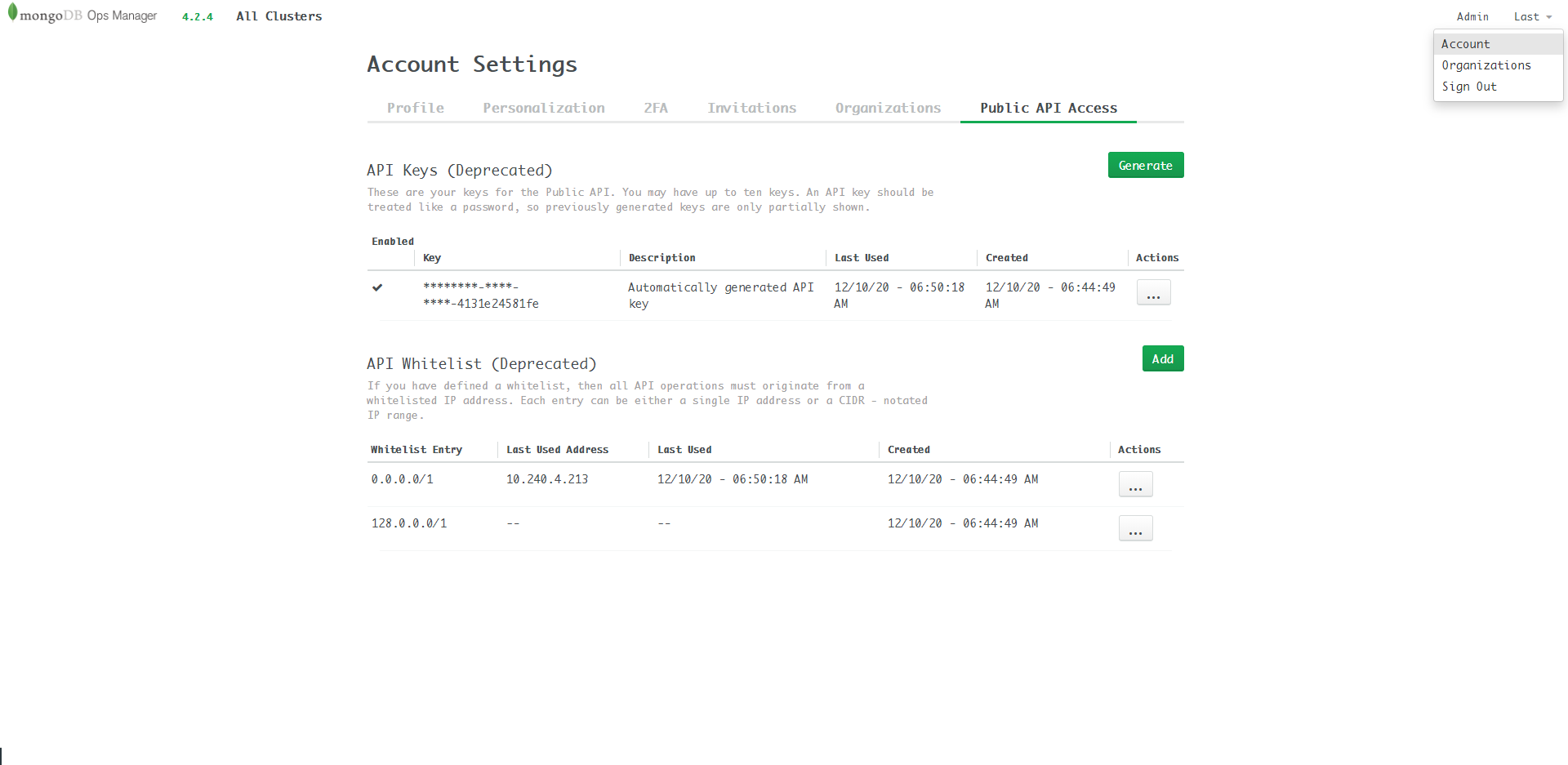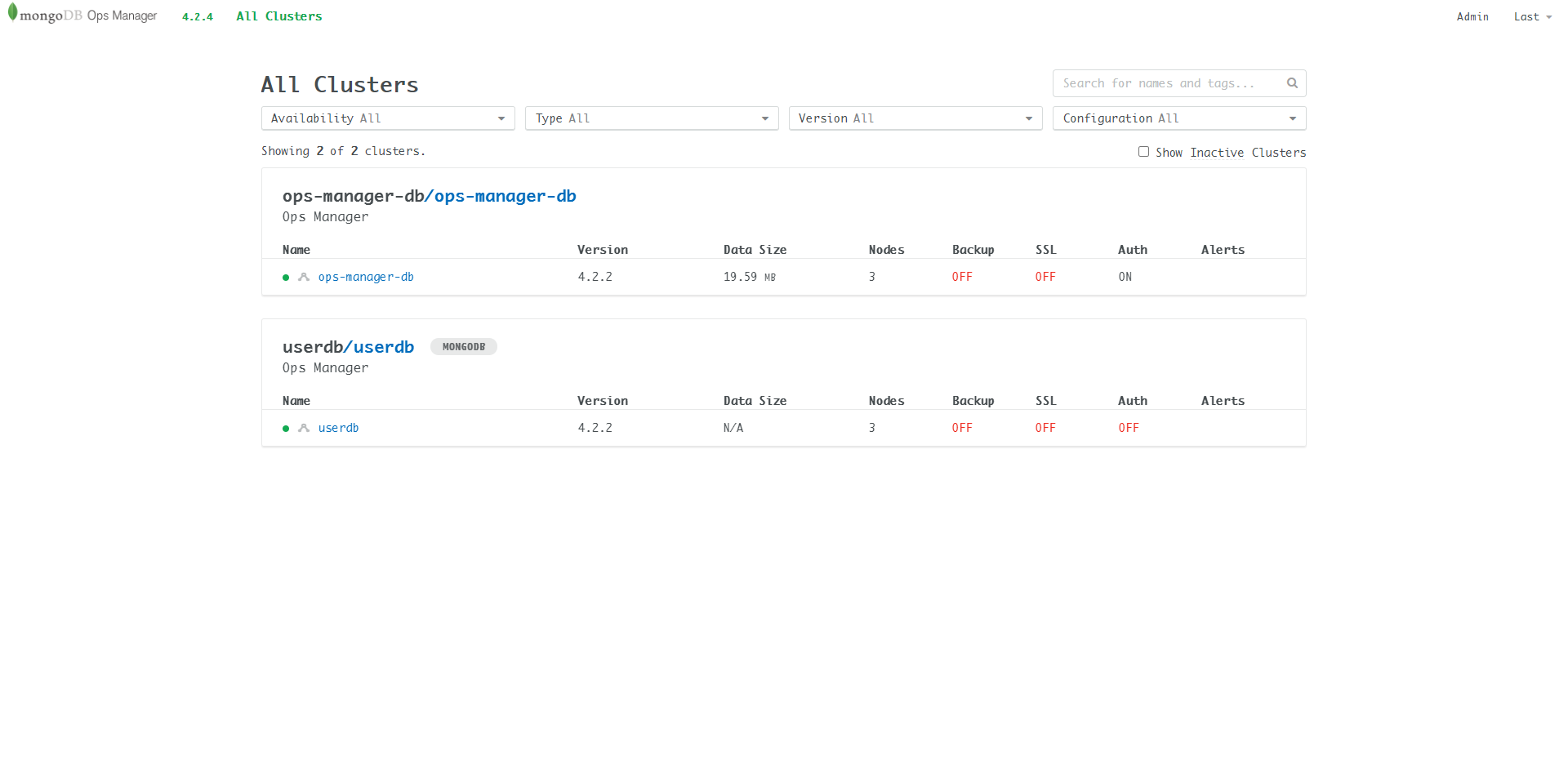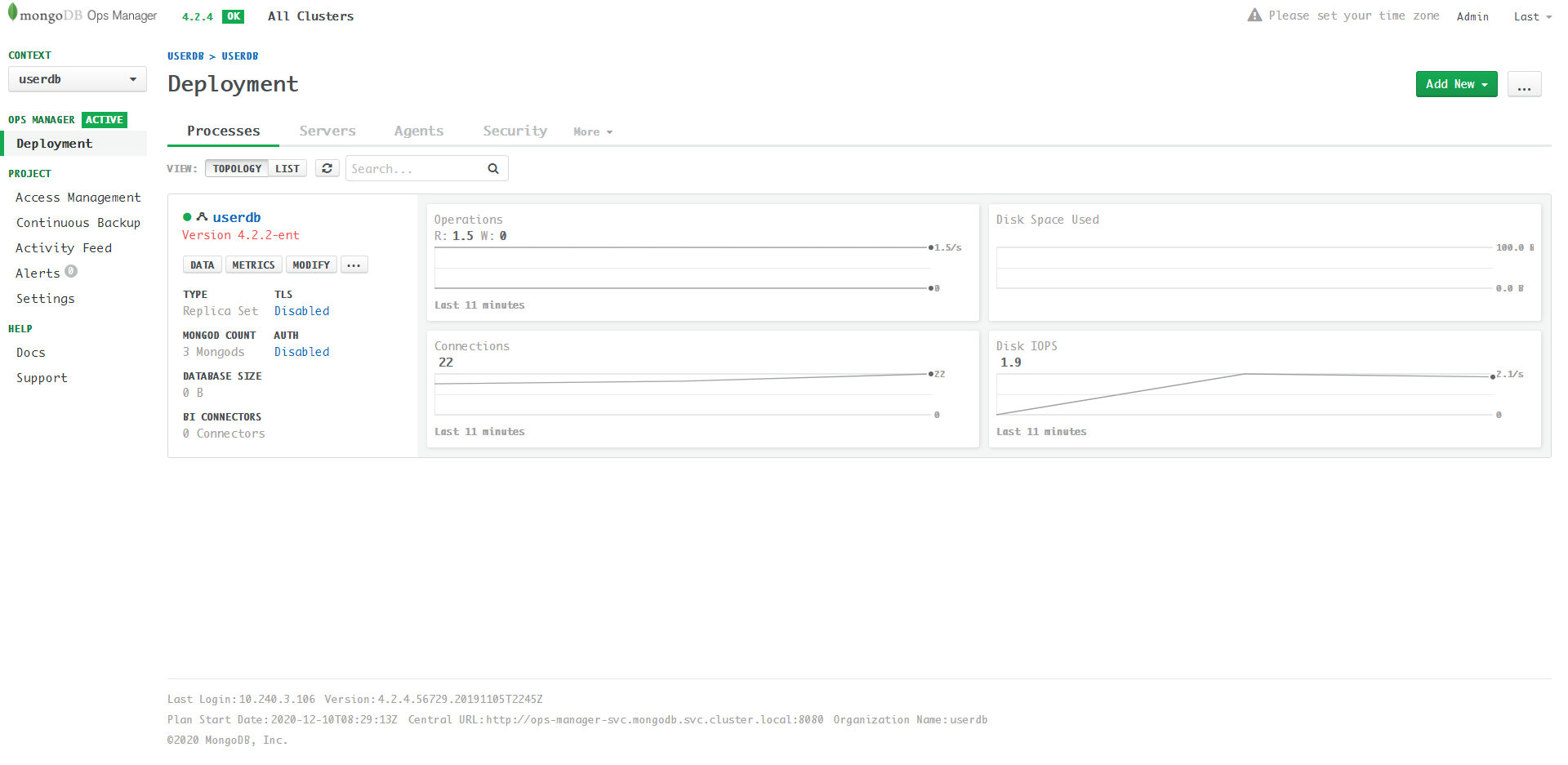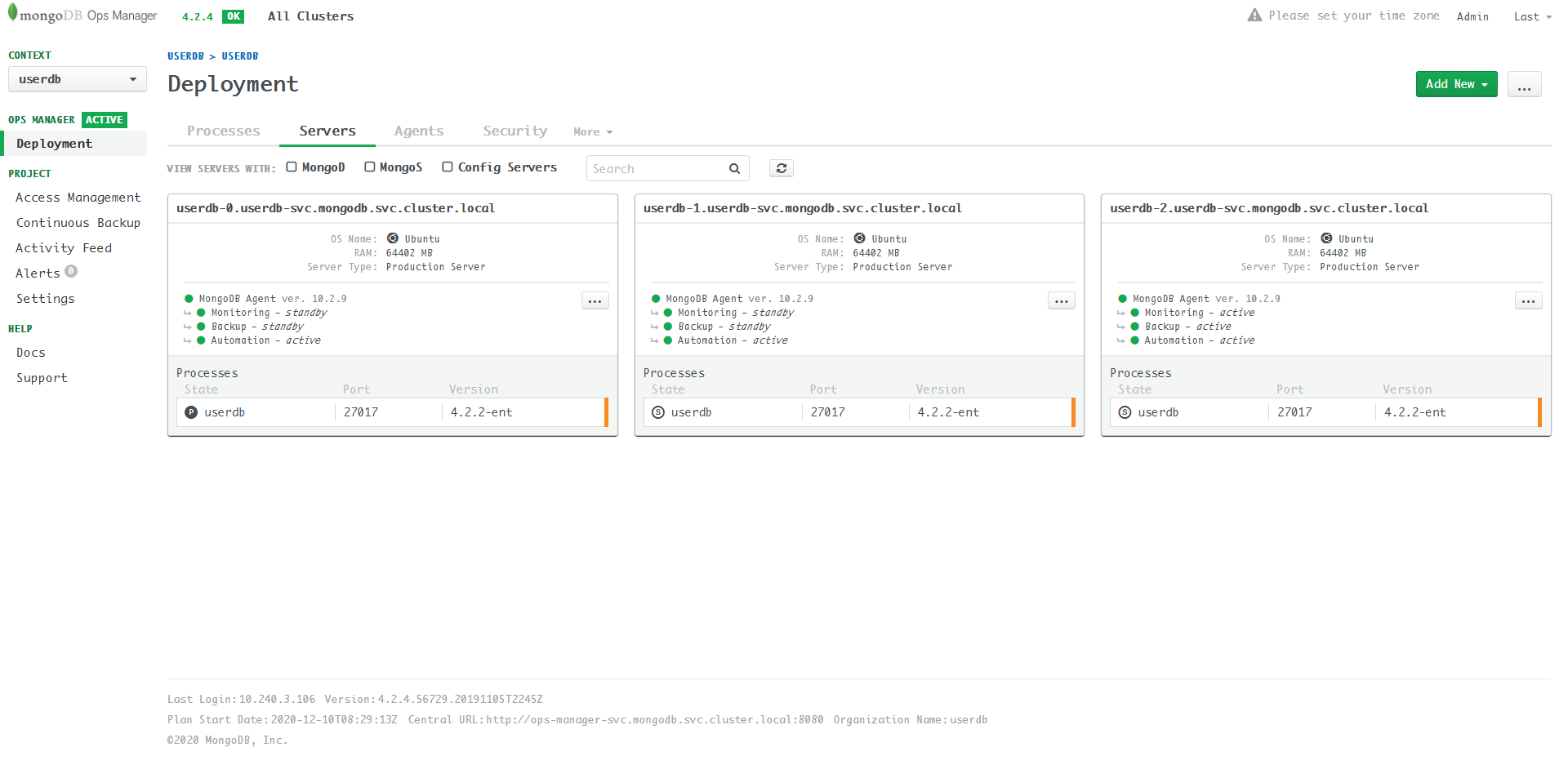MongoDB Cluster In Kubernetes(2): Create a UserDB ReplicaSet
This is part2, we will create a user database that is a 3 instances ReplicaSet.
MongoDB Ops Manager Series:
- Install MongoDB Ops Manager
- Create a UserDB ReplicaSet
- Expose UserDB to Public
- Openssl Generates Self-signed Certificates
- Enable UserDB TLS and Auth
The so called Application Database is the backend DB of
Ops Manager. It cannot be used to store user data. The user database is
called MongoDB Deployment. Note that the
deployment is different with Kubernetes
deployment.
For simplicity, we will create a replicaset instead of a sharded cluster. The configuration process is almost the same. Because sharded cluster consists of more components, the configuration is more complicated. Let's start with an easier one. :-)
Reference: Deploy MongoDB Sharded Cluster by Ops Manager
Unfortunately, creating user database cannot be directly done by the
Ops Manager web UI. Most of the operations should be performed by the
MongoDB Kubernetes Operator, aka the kubectl
command line. If you try to create it through web UI, you need to
manually configure variety of parameters and install Agents which I
don't know how to do it. So to my understanding, Ops Manager is a great
tool for visualization and automation tasks, but not good at cluster
manipulation. I think the reason is that the cluster specification is
too complicated to incorperated to the UI.
The
official blog created user database by a new generated API key.
However, I always failed with this method. I bypass the issue by
creating the user database by ops-manager-admin-key. Though
it's not recommended, it works. Update
2020-12-23: Please follow the official approach below. The 401
unauthorized issue is caused by that the API Key Secret username
is not the same with the admin username.
The Official Approach
Generate a Public API Key
Go to Ops Manager, "UserName -> Account -> Public API Access",
click the top right-most "Account": 
Note that the <apikey> appears only once, please
well remembered.
Create API Key Secret
Make sure that the user specified here is the same with the Ops Manager admin user!(created at Install MongoDB Ops Manager)
$ kubectl create secret generic om-user-credentials --from-literal="user=xxx@xxx.com" --from-literal="publicApiKey=<apikey>" -n mongodb
secret/om-user-credentials createdCreate Ops Manager Connection ConfigMap
Find Ops Manager url first:
$ kubectl get om ops-manager -o jsonpath='{.status.opsManager.url}' -n mongodb
http://ops-manager-svc.mongodb.svc.cluster.local:8080Create ops-manager-connection ConfigMap with the above URL:
$ kubectl create configmap ops-manager-connection --from-literal="baseUrl=http://ops-manager-svc.mongodb.svc.cluster.local:8080" -n mongodb
configmap/ops-manager-connection createdCreate User Database
userdb
Create the user database by kubectl, edit the
userdb.yaml and fill in credential and
configMap fields:
apiVersion: mongodb.com/v1
kind: MongoDB
metadata:
name: userdb
namespace: mongodb
spec:
members: 3
version: 4.2.2-ent
type: ReplicaSet
opsManager:
configMapRef:
name: ops-manager-connection
credentials: om-user-credentials$ kubectl apply -f userdb.yaml -n mongodb
mongodb.mongodb.com/userdb createdSimple(Crude) Approach (Not Recommended)
Please follow the official approach above.
You might encounter the following error after apply
userdb.yaml:
$ kubectl get mdb -n mongodb
NAME TYPE STATE VERSION AGE
userdb ReplicaSet Failed 4.2.2-ent 86s
$ kubectl describe mdb -n mongodb
Name: userdb
Namespace: mongodb
Labels: <none>
Annotations: kubectl.kubernetes.io/last-applied-configuration:
{"apiVersion":"mongodb.com/v1","kind":"MongoDB","metadata":{"annotations":{},"name":"userdb","namespace":"mongodb"},"spec":{"credentials":...
API Version: mongodb.com/v1
Kind: MongoDB
Metadata:
Creation Timestamp: 2020-12-10T08:19:02Z
Generation: 1
Resource Version: 52201207
Self Link: /apis/mongodb.com/v1/namespaces/mongodb/mongodb/userdb
UID: 8c04df70-5249-4c3b-8a28-3907890e4eb8
Spec:
Credentials: om-user-credentials
Members: 3
Ops Manager:
Config Map Ref:
Name: ops-manager-connection
Type: ReplicaSet
Version: 4.2.2-ent
Status:
Last Transition: 2020-12-10T08:20:33Z
Message: Failed to prepare Ops Manager connection: Error reading or creating project in Ops Manager: Status: 401 (Unauthorized), Detail: You are not authorized for this resource.
Observed Generation: 1
Phase: Failed
Version:
Events: <none>401 (Unauthorized) error, it seems that the generated key is not valid.
I found an API key in the Public API access page by
chance. Although the whole key is partially shown in the Ops Manager, we
can found the original key in the kubernetes secret:
ops-manager-admin-key. Let's check the last bits of the
ops-manager-admin-key in the Ops Manager: 
Modify the last line of userdb.yaml:
apiVersion: mongodb.com/v1
kind: MongoDB
metadata:
name: userdb
namespace: mongodb
spec:
members: 3
version: 4.2.2-ent
type: ReplicaSet
opsManager:
configMapRef:
name: ops-manager-connection
credentials: ops-manager-admin-keyAgain, this method is not recommended, but till now I don't find other alternatives.
A new statefulset userdb is creating, wait until the
state becomes "Running":
$ kubectl get mdb -n mongodb
NAME TYPE STATE VERSION AGE
userdb ReplicaSet Running 4.2.2-ent 13mRefresh the Ops Manager UI, click All Clusters, you will
find that there are 2 clusters with corresponding context
and Project: 
View userdb processes:  Found that both TLS and AUTH are
Found that both TLS and AUTH are
disabled. The transport layer communication is not
encryped, username/password is not required.
View userdb servers: 
Note that the server address is something like:
userdb-0.userdb-svc.mongodb.svc.cluster.local, which is an
internal address. Therefore, we cannot connect to the
userdb through Mongo Client.
Now the user database is sucessfully created!
Next we will expose the user database to the public by creating services: Expose UserDB to Public